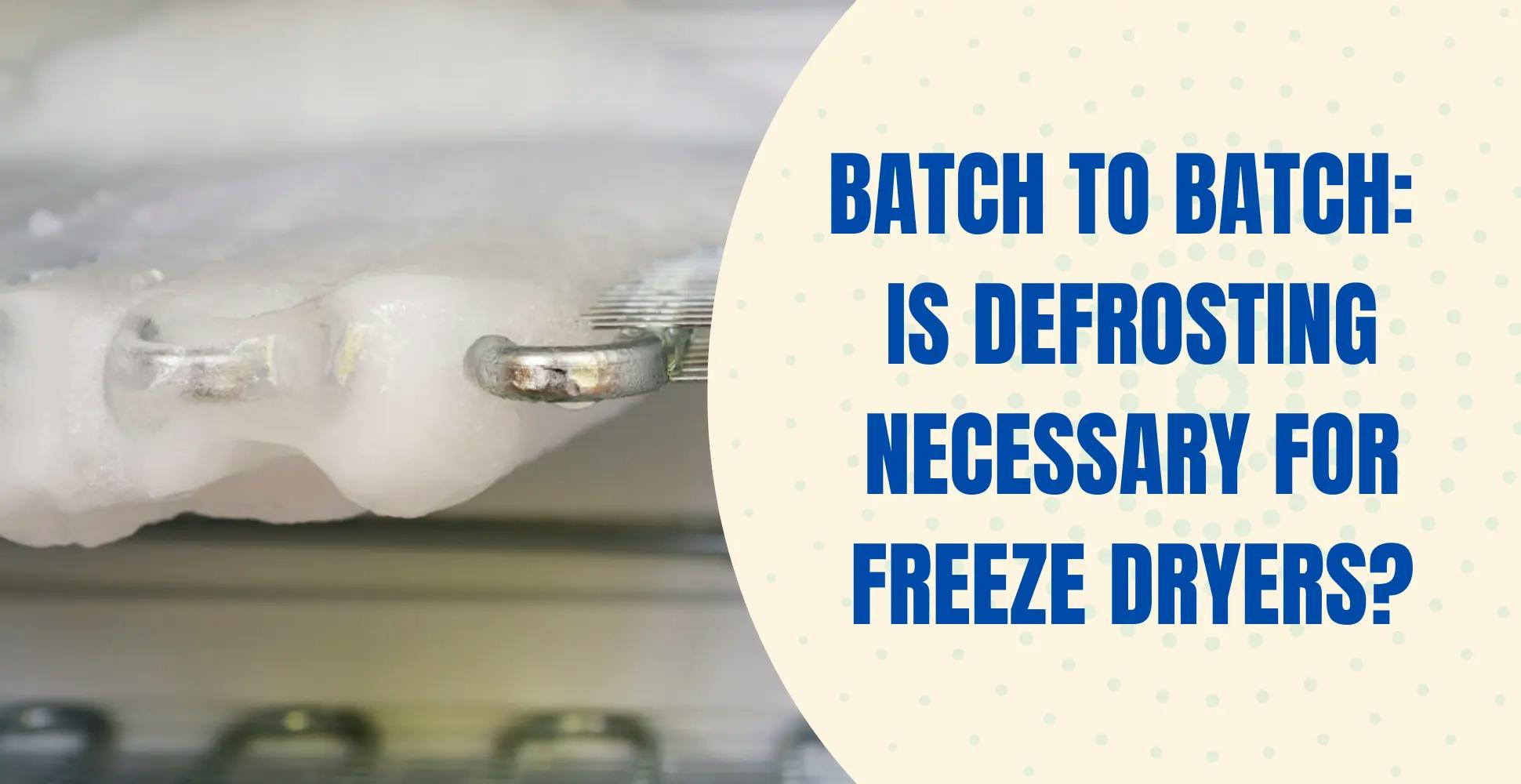Do You Have To Defrost Freeze Dryer Between Batches
 Dr. Tontul
Dr. Tontul- 10 Aug 2023

Introduction
Freeze drying has gained popularity due to its minimal impact on the nutritional value, flavor, and texture of foods. This process employs specialized equipment known as a freeze dryer, or lyophilizer. Therefore, understanding its proper usage is crucial for users.
This article explores the significance of defrosting, factors influencing the need for defrosting, best practices, and defrosting tips.
The Importance of Defrosting in a Freeze Dryer
Defrosting freeze dryers is essential for their functionality and upkeep. It involves removing the ice buildup that occurs during freeze drying.
Defrosting is vital to ensure proper airflow, which is necessary for effective freeze drying. By maintaining optimal airflow, the freeze drying machine prevents potential blockages and operates efficiently.
Consistent defrosting keeps the machine working effectively. Ice accumulation within the chamber or on shelves can lead to temperature fluctuations and uneven drying. Following the manufacturer's guidelines regarding defrosting frequency and methods is essential.
Defrosting is accomplished manually by using warm water to melt the ice in basic equipment. Some advanced models feature automated defrost cycles.
In summary, defrosting is necessary to optimize the performance and lifespan of the freeze dryer. It prevents ice buildup and ensures the proper functioning of the drying process.
Factors Determining the Need for Defrosting
The batch size of freeze-dried food items is a crucial factor affecting defrosting. Larger batches may require longer defrosting periods to ensure complete ice removal. Additionally, the moisture content of foods influences the defrosting process. Foods with higher moisture content may take longer to thaw than those with lower moisture content.
Lastly, the capacity of the freeze dryer should be considered when planning defrosting procedures. The machine's capacity determines the volume of product that can be processed at once, which in turn affects the frequency of defrosting based on production needs.
Best Practices for Defrosting a Freeze Dryer Between Batches
When it comes to freeze dryers, employing proper defrosting techniques is essential to ensure optimal performance and durability of the equipment. Two primary methods are used: manual defrost and automatic defrosting.
Manual defrost allows the ice buildup to thaw naturally after each freeze drying cycle. This method demands more time and effort but enables thorough cleaning of all freeze dryer components.
On the other hand, automatic defrost systems utilize built-in heaters or hot gas to melt the ice buildup. This approach is quicker and more convenient, eliminating the need for manual intervention. However, it might not provide the same level of thorough cleaning as manual defrosting.
In addition to regular defrosting, maintaining routines like cleaning filters, inspecting seals, and lubricating moving parts is crucial for optimal freeze dryer operation.
By following these best practices for defrosting your freeze dryer between batches, you can maintain its efficiency and extend its lifespan while ensuring high-quality results in your freeze-dried products.
Tips for Maximizing Efficiency and Minimizing Defrosting Requirements
Several key tips contribute to efficiency optimization and reduced defrosting needs.
Firstly, evenly load food items onto trays or shelves within the freeze dryer. This ensures proper circulation of cold air and uniform freezing. Avoiding overcrowding or uneven distribution leads to more consistent results and shorter defrosting durations.
Another helpful tip is to pre-freeze food items before placing them into the freeze dryer. This step accelerates the overall process and minimizes energy consumption.
Maintaining Your Freeze Dryer for Optimal Performance and Longevity
A freeze dryer is a valuable yet costly investment for preserving and extending the shelf life of various products. To ensure its longevity, adopt regular cleaning and maintenance routines, monitor temperature and vacuum levels, and replace worn-out parts as necessary. Let's examine the significance of each practice in maintaining your freeze dryer.
Regular Cleaning and Maintenance Routines
Regular cleaning is essential to prevent contamination that could compromise the freeze dryer's efficiency and product quality. Follow these steps for effective cleaning and maintenance:
Interior Cleaning: After each use, clean the interior of the freeze dryer chamber using a mild detergent and warm water. Remove all residue from shelves, trays, and walls. Wipe the gaskets and seals to prevent leaks.
Exterior Cleaning: Regularly wipe down the exterior surfaces of the freeze dryer to prevent dust buildup. Avoid using abrasive cleaners that might damage the finish.
Condenser Maintenance: The condenser plays a critical role in eliminating moisture from the product. Regularly defrost and clean the condenser to maintain its efficiency. Adhere to the manufacturer's defrosting frequency guidelines.
Monitoring Temperature and Vacuum Levels
Accurate temperature and vacuum control are crucial for successful freeze drying. Monitoring these parameters ensures optimal freeze dryer operation:
Temperature Control: Regularly calibrate temperature sensors to ensure accurate readings. Incorrect temperature settings can result in uneven drying or product damage.
Vacuum Level Monitoring: Keep an eye on vacuum levels during freeze drying. Vacuum pressure fluctuations could indicate leaks or vacuum pump issues. Promptly address any abnormal readings to avoid compromising the freeze-drying process.
Replacing Worn-Out Parts as Needed
Over time, certain components of the freeze dryer may experience wear and tear. Timely identification and replacement of these parts are essential:
Seals and Gaskets: Regularly inspect seals and gaskets for signs of wear or damage. Worn seals can lead to vacuum leaks, affecting the freeze dryer's efficiency.
Vacuum Pump Maintenance: The vacuum pump is a critical component. Adhere to the manufacturer's recommendations for regular maintenance, including oil changes and filter replacements.
Heating Elements: Uneven drying or temperature inconsistencies could result from worn-out heating elements. Replace them as necessary to ensure consistent performance.
Frequently asked questions (FAQ)
Can I defrost my freeze dryer with a hair dryer?
Yes, you can use a hair dryer to defrost your freeze dryer. However, be careful that melting ice does not drip into the hair dryer and cause electric shock.
Conclusion
Defrosting is a pivotal aspect of freeze dryer maintenance, playing a crucial role in maintaining the efficiency and longevity of the equipment. Regular defrosting not only aids in consistent performance but also contributes to the overall quality of freeze-dried products.
Several factors, such as batch size, moisture content, and freeze dryer capacity, determine defrosting requirements.
Adhering to best practices for defrosting, which encompass both manual and automatic methods, is vital. These practices, along with maintenance routines like cleaning and inspecting seals and sensors, ensure that the freeze dryer operates optimally and yields high-quality results.
